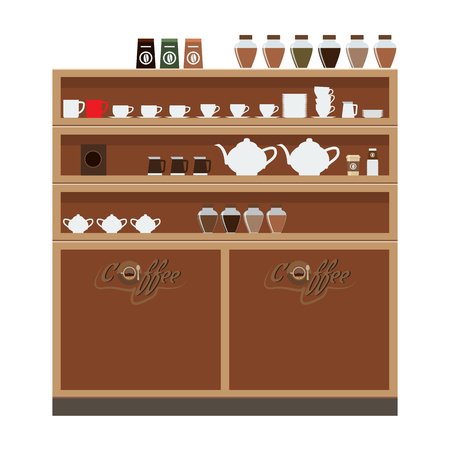The Allure of Vintage Coffee Machines in the UK
There’s something undeniably charming about vintage coffee machines, particularly within the context of British culture. From the bustling high streets of London to the quiet corners of market towns, classic espresso makers and percolators evoke a sense of nostalgia that resonates with both seasoned café owners and keen home enthusiasts. The British fascination with these timeless machines is rooted not only in their elegant designs but also in their pivotal role within our evolving café culture—a culture that values both tradition and innovation.
Historically, Britain’s relationship with coffee can be traced back to the coffee houses of the 17th century, which were once lively hubs for intellectual discussion and social exchange. While tea may have become the nation’s signature beverage, the allure of coffee has endured, evolving alongside changing tastes and technologies. Today, as specialty coffee continues to thrive across the UK, there is a growing movement among collectors who are passionate about restoring vintage machines to their former glory. These individuals are drawn by more than just aesthetics; they appreciate the craftsmanship, reliability, and unique flavour profiles that classic machines can deliver.
Moreover, this revival has given rise to a vibrant community—both online and offline—where knowledge, spare parts, and restoration tips are freely exchanged. Whether it’s a gleaming Faema E61 spotted in an independent café or a cherished Gaggia tucked away in a home kitchen, vintage coffee machines have become symbols of personal expression and cultural heritage. As we continue to embrace new trends in brewing, these classics remind us of our rich history while offering a rewarding hands-on experience for collectors across Britain.
2. Sourcing Gems: Tracking Down Vintage Machines Across Britain
For British collectors, the thrill of restoring vintage coffee machines often begins with the hunt itself. The UK offers a treasure trove of opportunities for sourcing authentic classics, if you know where to look and what to look out for. Here’s a practical guide to unearthing those hidden gems.
Where to Search for Vintage Coffee Machines
| Venue | Description | Top Tips |
|---|---|---|
| Local Auctions | A fantastic source for rare finds, especially estate or house clearance sales. | Check auction catalogues in advance and attend viewings; always inspect machines closely for missing or non-original parts. |
| Charity Shops | Occasionally, vintage machines appear as donations in high-street charity shops. | Frequent visits pay off; build rapport with staff who may give you a heads-up on new arrivals. |
| Car Boot Sales | Popular across Britain, these informal markets can yield unexpected treasures at bargain prices. | Arrive early for the best selection; bring cash and be prepared to haggle politely. |
| Specialist Dealers | Dealers focusing on vintage kitchenware or coffee equipment offer curated selections. | Expect higher prices but better provenance; ask about machine history and request any available documentation. |
How to Spot a Worthwhile Project
- Check for Completeness: Ensure all essential components (portafilter, boiler, group head) are present. Missing parts can be difficult or costly to replace.
- Assess Condition: Surface rust is usually manageable, but beware of deep corrosion or cracks in metal bodies—these may compromise safety or be beyond economical repair.
- Brand & Model Rarity: Italian brands like Gaggia, Faema, or classic British makes such as Atomic or La Pavoni are highly sought-after. Research typical values and common pitfalls before committing.
Common Pitfalls to Avoid
- Avoid machines that have been heavily modified unless you’re confident in restoring originality.
- If possible, test electrical components on-site using a portable PAT tester or seek assurance that the wiring is intact—especially with older UK models that may predate modern standards.
A Final Word on Sourcing
The joy of vintage restoration lies as much in the search as in the end result. Patience, curiosity, and a bit of British determination go a long way when tracking down your next project. With each find, you’re not just acquiring an appliance—you’re preserving a piece of coffee culture history.

3. Assessing Condition: What to Look For Before You Buy
A Practical Checklist for British Collectors
Before you hand over your hard-earned pounds for a vintage coffee machine, it pays to approach the purchase with a critical eye. Whether you’re considering a classic Gaggia, an iconic La Pavoni, or one of the stalwart British brands like Swan or Morphy Richards, a thorough assessment will help you avoid costly mistakes and ensure your restoration project starts off on the right foot.
Mechanical Evaluation: The Heart of the Machine
Boiler & Heating Element: Check for obvious leaks, signs of limescale build-up, and any corrosion around welds or fittings. In Britain’s hard-water regions, scale can be a particular nuisance—look inside if possible.
Pump & Pressure System: Listen for unusual noises when powered up (if safe to do so) and inspect pressure gauges for responsiveness.
Valves & Seals: Ageing rubber can perish or crack, leading to poor seals and leaks. Replacement is usually feasible but factor in the cost.
Wiring & Electrical Safety: Old British plugs and wiring may not meet modern standards. Frayed cords or bodged repairs are red flags; expect to rewire most finds from the 1960s-80s.
Aesthetic State: Character vs. Catastrophe
Bodywork & Finish: Superficial scratches, faded paintwork, or minor dents are par for the course and can add character. However, deep rust—especially around structural joints—can signal hidden problems.
Dials, Levers & Knobs: Original parts are prized among UK collectors; replacements may reduce value, especially if poorly matched.
Branding & Badging: Machines from British makers like Russell Hobbs often feature unique badges. Faded or missing insignia can be tricky (but sometimes rewarding) to restore.
Typical Faults by Brand
Swan & Morphy Richards: Expect dried-out seals and worn heating elements. Parts are relatively accessible in the UK.
La Pavoni & Gaggia (imported classics): Chrome pitting and pressure issues are common; check lever action for smoothness.
What Can Realistically Be Restored?
The good news for British enthusiasts is that many mechanical faults—such as tired pumps or perished seals—are well within reach for home engineers armed with patience and basic tools. Cosmetic issues like faded enamel or tarnished chrome require more elbow grease but can be tackled with supplies from high street hardware shops. However, beware machines with severe boiler corrosion or major electrical faults unless you’re comfortable with advanced repairs or have access to specialist support.
This careful assessment process is both practical and part of the fun—spotting a hidden gem at a car boot sale or online auction is all the sweeter when you know what’s fixable and what’s best left behind.
4. Essential Tools and Spare Parts: Planning Your Restoration
Before diving into the restoration of a vintage coffee machine, it’s crucial to gather the right tools and spare parts—especially when working with classic models found across Britain. A well-organised toolkit not only makes the process smoother but also minimises the risk of damaging rare components. Below, you’ll find an overview of must-have tools, advice on sourcing British parts suppliers, and tips for dealing with those tricky obsolete fittings.
Basic Toolkit for Vintage Revival
Restoring classic machines requires more than just standard household tools. Here’s a breakdown of essential items every collector should have at hand:
| Tool | Purpose |
|---|---|
| Precision Screwdrivers | For delicate screws often found in old mechanisms |
| Spanners & Socket Sets | Tightening/loosening nuts in confined spaces |
| Multimeter | Testing electrical circuits safely |
| Brass Brushes | Cleaning corrosion without scratching surfaces |
| Gasket Picks | Removing old seals cleanly |
| Needle Files | Smoothing rough metal edges or customising new parts |
| Lubricants (Food Safe) | Ensuring smooth moving parts post-restoration |
| Soft Cloths & Microfibre Towels | Gentle polishing and drying after cleaning |
Navigating British Suppliers for Parts
Sourcing genuine or compatible spare parts can be one of the most challenging aspects of restoration in the UK, especially given the variety of European and domestic brands that have graced British kitchens over the decades. The following strategies can help:
- Specialist Dealers: Seek out established UK-based suppliers such as Coffeecollective.co.uk or EspressoParts.co.uk. They stock gaskets, group handles, and boiler components for many vintage models.
- Auction Sites & Car Boot Sales: eBay UK and local car boot sales are treasure troves for obscure parts—though patience is key.
- Coffee Forums: Platforms like Coffee Forums UK often have active members swapping or selling spares, plus invaluable advice from experienced restorers.
- Bespoke Machinists: For truly obsolete parts, consider contacting small engineering firms that offer custom machining—this is more common than you might expect in Britain’s industrial heartlands.
Tackling Obsolete Fittings: A Hands-On Approach
No guide would be complete without addressing the frustration of obsolete fittings and non-standard threads. Many classic machines were built before today’s standards, making replacement less straightforward. Here’s how to approach these obstacles practically:
- Thread Gauges: Invest in a set to identify unusual thread sizes accurately before ordering or fabricating replacements.
- Adaptors: Where possible, use brass or stainless-steel adaptors to bridge between legacy and modern fittings—available from plumbing suppliers or custom-made.
- Spares Salvage: If you acquire non-working donor machines, keep every fitting—they’re often irreplaceable on the open market.
- Tapping & Die Sets: For advanced tinkerers, re-threading parts can restore usability where exact matches are impossible to source.
The British Collector’s Mindset: Resourcefulness Over Perfection
The real joy of restoring vintage coffee machines lies as much in resourceful problem-solving as it does in the final cup pulled. With patience, a well-stocked toolkit, and connections among Britain’s vibrant enthusiast community, even the most daunting restoration projects become achievable—and deeply rewarding.
5. Restoration Fundamentals: Cleaning, Repairing and Reassembly
Step 1: Documenting Before Disassembly
Before you pick up a spanner or screwdriver, it’s essential to document your machine thoroughly. Take detailed photos from every angle—close-ups of wiring, valves, and any unique British fittings are especially helpful. Make notes of any markings or serial numbers; these will prove invaluable for both sourcing parts locally and verifying authenticity.
Step 2: Cleaning with Care
Begin by gently cleaning exterior surfaces using mild, non-abrasive cleaners suited to the original finish—enamel, stainless steel, or brass. For scale and internal build-up, use food-safe descaling solutions, paying special attention to boiler components and group heads. Always avoid aggressive chemicals that might compromise patina or historic decals, as preserving the period-correct appearance is highly valued among British collectors.
Step 3: Assessing and Repairing Components
Once cleaned, inspect all mechanical and electrical parts for wear or damage. Replace perished gaskets, O-rings, and seals with food-grade equivalents sourced from reputable UK suppliers. If rewiring is necessary, ensure all work complies with British electrical standards (BS 7671). When fabricating or replacing parts, try to match original materials and finishes where possible to maintain the machine’s heritage value.
Step 4: Balancing Authenticity and Reliability
This stage requires a careful balance between originality and modern usability. Where feasible, retain key original components such as pressure gauges or lever mechanisms; however, don’t hesitate to upgrade safety-critical elements like pressure relief valves or power cords to current British standards. Many UK collectors opt for discreet modern upgrades that do not detract from the machine’s classic look but ensure safe operation in daily use.
Step 5: Reassembly with Precision
Reassemble slowly and methodically, referring to your photographs at every stage. Lubricate moving parts sparingly with food-safe lubricants and double-check all fasteners for correct torque—over-tightening can be just as damaging as leaving something loose. Once reassembled, conduct a thorough leak test and verify all safety interlocks before introducing water or electricity to the system.
A Final Word on Safety
No restoration is complete without a final inspection against current British safety regulations. Consider having a qualified electrician conduct a PAT (Portable Appliance Test) before first use. This not only ensures peace of mind but also adds credibility should you ever wish to exhibit your machine at a local coffee show or collector’s fair.
6. The Joy of Use: Brewing with British Heritage
There’s something innately satisfying about brewing a fresh cup with a vintage coffee machine, particularly when that machine has been lovingly restored by your own hands. Each quirk—be it the slight hiss of steam or the gentle resistance of an old lever—adds to the experience, connecting you to decades of British coffee tradition. These tactile moments are worlds apart from the sterile automation of modern appliances; they invite you to slow down and appreciate the artistry in every cup.
Celebrating Character and Craft
Using a vintage coffee machine isn’t just about nostalgia—it’s about embracing the imperfections and idiosyncrasies that give each brew its character. Perhaps your 1950s Gaggia needs a careful eye on water temperature, or your restored La Pavoni rewards patience with a rich crema. These quirks become part of your daily ritual, infusing each morning with a sense of achievement and continuity.
Classic British Coffee Styles to Try
Why not honour your restoration work with some beloved British coffee classics? Start with a traditional White Coffee, simply strong filter coffee with a splash of milk—ideal for savouring subtle notes brought out by older machines. Or attempt a Café au Lait, pairing freshly brewed coffee with steamed milk for a creamy finish reminiscent of mid-century British cafés. For those who enjoy something sweet, a homemade Coffee and Walnut Cake alongside your brew brings together two staples of British hospitality.
Sharing Your Journey
The joy multiplies when shared within the community. Consider posting before-and-after photos or brewing tips on local forums like UK Coffee Forums or even at village fêtes. Many enthusiasts find immense satisfaction in swapping stories over a cup, learning new tricks, or even trading spare parts. By sharing your restoration journey, you not only preserve these classic machines but also help keep Britain’s rich coffee heritage alive for future generations.
Ultimately, restoring and using vintage coffee machines is more than a hobby—it’s a celebration of craftsmanship, history, and daily pleasure. Each cup you brew is both an act of remembrance and an invitation to others to join in this enduring British tradition.

